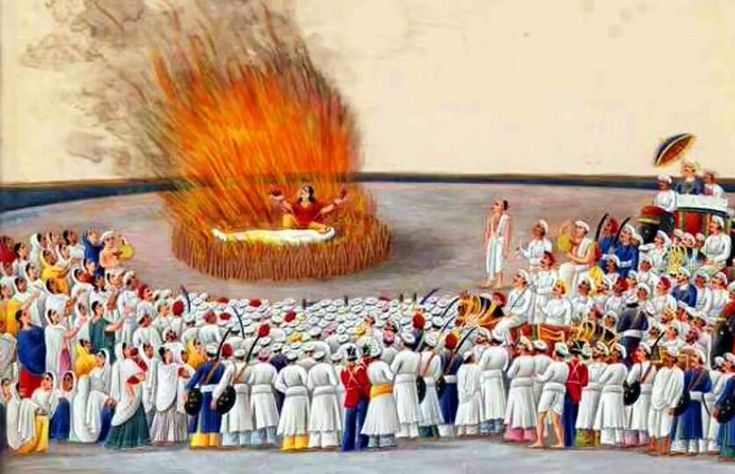Trigger Warning: This article contains descriptions of forced violence against women, including child victims.

What Was Sati?
Sati was an ancient Hindu practice where a woman, after her husband’s death, was expected to burn herself alive on his funeral pyre. People said it was a symbol of a woman’s loyalty and love for her husband. But in reality, many women were not given a choice. They were either forced or socially pressured to commit this act. It became known as “Sati Mata” in many places, and temples were even built to honor women who died this way. But was it truly an honorable sacrifice or a brutal crime disguised as a religious duty?
In ancient Hindu society, being a widow was seen as shameful. A widow who didn’t perform Sati had to live a life of hardship. She had to shave her head, wear white, eat simple food, and live apart from society. This made many women feel that death was better than this kind of life.
French traveler François Bernier, who lived in 17th-century India, wrote about what he saw. His accounts tear down the lie that Sati was always voluntary.
He saw young girls—barely teenagers—crying, trembling, trying to run from the fire, only to be tied down and pushed back in with sticks.
He said:
In many areas, Brahmins forced women onto the pyre — even tying their hands and feet so they couldn’t escape.
Where is Sati Mentioned?
Sati appears in both religious texts and historical records. Here are some key examples:
- Oldest Record (317 BCE): A Greek historian named Diodorus wrote about Sati in his book Bibliotheca Historica. He described an Indian general named Keteus (possibly a Kshatriya from Punjab) whose younger wife burned with him after his death in battle. His older wife couldn’t because she was pregnant.
- Mahabharata: This ancient Indian epic mentions Sati several times. For example, Madri, the second wife of Pandu, burned herself after his death. Draupadi, another famous character, was almost forced to perform Sati for a man named Kichaka, but she was saved. Other women, like Krishna’s and Vasudev’s wives, also performed Sati.
- Religious Texts: Some texts, like the Brahma Purana (12th–13th century CE), praised Sati, saying women who did it were “loyal and pure” and would go to heaven. The Parashara Smriti even claimed a woman who performed Sati would stay in heaven for countless years. However, earlier texts like the Rig Veda (4th century BCE) and Taittreya Aranyaka (3rd century BCE) supported widow remarriage instead of Sati, suggesting a woman should leave the pyre and remarry.
- Later Texts: By the Gupta period (around 400 CE), texts like Agni Purana and Vishnu Smriti encouraged Sati, saying it was a woman’s duty. But a writer named Banabhatta, in the 7th century, criticized Sati, calling it a “childish act” that didn’t help the husband and only caused misery.
Sati wasn’t always supported by religious texts, but it became more common over time, especially during the Gupta period (4th–6th century CE).

How Was Sati Done?
The process of Sati was painful and public. Here’s how it often happened, based on eyewitness accounts:
- Preparation: The widow was sometimes dressed like a bride, with jewelry and fine clothes. She might bathe, wear white unstitched clothes, and take off her jewelry before the fire. In some cases, she walked to the pyre with relatives singing praises or chanting mantras.
- The Act: The widow was placed on the pyre with her husband’s body or his sandals (if he died elsewhere). The fire was lit, and people sometimes added wood or ghee (clarified butter) to make it burn faster. Drums were played to drown out her cries, and men with sticks ensured she didn’t escape.
- Mass Sati: When a king or nobleman died, many of his wives or concubines might be forced to burn together. For example, a Portuguese traveler named Duarte Barbosa (16th century) said 400–500 women could burn for one king’s death.
There were two types of Sati:
- Sahamarana: Burning with the husband’s funeral pyre.
- Anumarana: Burning on a separate pyre, days or weeks later, often with the husband’s sandals.
Some rules existed. For example, pregnant women or those on their periods couldn’t perform Sati until later, but these rules didn’t always protect them.
Was Sati Forced or Willing?
1. Lahore – 12-Year-Old Widow
Bernier witnessed a 12-year-old girl in Lahore, crying and trembling before being forced into the fire. Her feet and hands were tied, and she was pushed back into the flames with sticks when she tried to escape.
Bernier wrote:
“I have seen them run out of the fire and be thrown back in… This is not honor, this is horror.”
2. 14-Year-Old Girl – 1820, Calcutta
In another case recorded by a British officer, She was a Brahmin, only 14, and her uncle Shivlal decided she should become Sati. When the fire was lit, she ran out, crying and begging for her life.
She said, “Let me live, I’ll beg on the streets, but I don’t want to die.”
So what did Shivlal do?
He wrapped her in white cloth, held her down, and when she resisted again, he stabbed her with a sword. Then he threw her body into the flames.
Over 200 people watched. No one stopped it.
The punishment? Shivlal got only two years in jail.
3. Slave Women Burned Alive
Bernier also wrote about a noblewoman who died. She wasn’t alone on the pyre. She had five slave women who were also forced to burn with her—even though they weren’t her wives.
He said:
“Even dogs would not be treated this way. Yet women are.”
Was Sati Only for Upper Castes?
No, Sati wasn’t limited to upper castes (like Brahmins and Kshatriyas). While it was more common among them, lower-caste women also practiced it. Examples include:
4. Baranagar, Calcutta
One British officer described a horrible scene.
The widow of a washerman was made to lie on the pyre with wooden blocks placed on her so she couldn’t escape. Four men held bamboo poles to pin her down as she burned.
A British officer watching the scene was so disturbed, he had to walk away. He said:
“Her legs were burning… she was screaming, but no one helped. Even her own mother and sister stood silently in the crowd.”
The officer, horrified, had to turn away. He couldn’t bear the screams.
Did Sati Start Because of the Turks?
Some people believe Sati became popular because of Turkish invasions, but this is a myth. Sati existed long before the Turks arrived:
- The earliest recorded Sati was in 317 BCE, long before the Turks.
- Sati became more common during the Gupta period (4th–6th century CE), which was considered a “golden age” of Hindu/Brahmin culture, not during Turkish rule.
- Travelers like Ibn Battuta and Francois Bernier noted that Delhi Sultans and Mughals tried to reduce Sati by requiring permission or discouraging it, though it was still practiced.
So, Sati was an ancient practice rooted in Indian society, not caused by foreign rulers.
Why Was Sati So Common?
Sati was common for several reasons:
- Social Pressure: Society glorified Sati as a noble act, and families gained respect if a widow performed it. Refusal brought shame.
- Age Gaps: Texts like the Manusmriti allowed older men (e.g., 30 years old) to marry young girls (e.g., 12 years old). These girls often became widows at a young age and were pressured into Sati.
- Public Rituals: Sati was a public event with 200–300 people watching, adding pressure on the widow to go through with it.
- Lack of Options: Widows who didn’t perform Sati faced a harsh life, making death seem like the only way to avoid suffering.
- Respect and Honor: Sati brought honor, while refusing brought shame.
Conclusion
Sati was a painful and often forced practice that caused immense suffering for women in ancient India. It was mentioned in religious texts, historical records, and epics like the Mahabharata, showing it was deeply rooted in society. While some women may have chosen it due to conditioning, many were forced, including young girls as young as 12 or 14. It wasn’t limited to upper castes and wasn’t caused by Turkish invasions. Understanding Sati helps us see the challenges women faced in the past and reminds us to value their rights and choices today.
Sources
All historical incidents and quotes in this article are based on:
- François Bernier’s Travels in the Mughal Empire
- British colonial records
- Raas Mala historical text
Here are a few papers/ books that you can read for more info on The History of the Practice of Sati:
John S. Hawley – The History of the Practice of Sati
Sati: The Blessing and the Curse – Edited by John S. Hawley, 1994
H.T. Colebrooke – Miscellaneous Essays, Volumes 1 and 2, 1837
J.L. Shastri – Agni Purana Unabridged, 1998
Jörg Fisch – Dying for the Dead: Sati in Universal Context, 2005
B. Vaitheeswaran – Parashara Smriti
Sakuntala Narasimhan – Sati: A Study of Widow Burning in India, 1990
Andrea Major – Sati: A Historical Anthology, 2007
Lourens P. van den Bosch – A Burning Question: Sati and Sati Temples as the Focus of Political Interest, 1990
Arvind Sharma – Sati: Historical and Phenomenological Essays, 1988
Upendra Thakur – A History of Suicides in India, 1963
A.K. Forbes – Rasmala, 1978
H. Wilberforce – History of Kathiawar, 1917